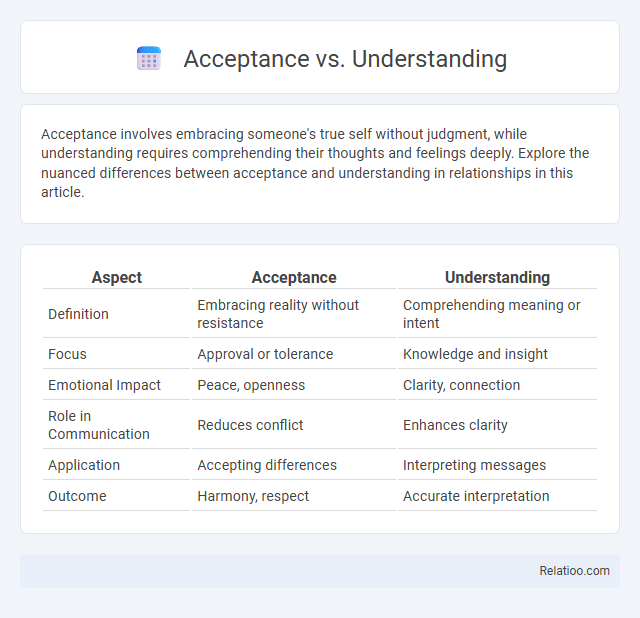Acceptance involves embracing someone's true self without judgment, while understanding requires comprehending their thoughts and feelings deeply. Explore the nuanced differences between acceptance and understanding in relationships in this article.
Table of Comparison
| Aspect | Acceptance | Understanding |
|---|---|---|
| Definition | Embracing reality without resistance | Comprehending meaning or intent |
| Focus | Approval or tolerance | Knowledge and insight |
| Emotional Impact | Peace, openness | Clarity, connection |
| Role in Communication | Reduces conflict | Enhances clarity |
| Application | Accepting differences | Interpreting messages |
| Outcome | Harmony, respect | Accurate interpretation |
Defining Acceptance and Understanding
Acceptance involves recognizing a situation or reality without resistance or denial, embracing it as it is. Understanding requires comprehending the reasons, causes, or underlying principles behind a situation, leading to deeper insight. Unlike acceptance, which is about acknowledging fact, understanding seeks to explain and make sense of that fact.
Key Differences Between Acceptance and Understanding
Acceptance involves embracing reality or a situation without resistance, while understanding requires comprehending the reasons or causes behind it. Your ability to accept does not necessarily mean you fully understand why something happens; acceptance is often emotional and passive, whereas understanding is cognitive and active. Key differences include acceptance fostering peace despite uncertainty, whereas understanding promotes insight and informed decision-making.
The Role of Empathy in Both Concepts
Empathy plays a crucial role in both acceptance and understanding by allowing individuals to resonate with others' feelings and perspectives. Acceptance involves embracing differences without judgment, fostering emotional safety, while understanding requires a deeper cognitive engagement to grasp the reasons behind behaviors or beliefs. Empathetic resonance bridges emotional and intellectual processes, enhancing interpersonal connections and promoting compassion in diverse social interactions.
Psychological Impact of Acceptance vs Understanding
Psychological impact of acceptance involves embracing reality and emotions without resistance, leading to reduced stress and increased emotional resilience. Understanding, on the other hand, requires cognitive processing and insight, fostering problem-solving and empathy but may not immediately alleviate emotional distress. Acceptance promotes mental well-being by decreasing internal conflict, while understanding supports adaptive coping through clarity and perspective.
Common Misconceptions
Common misconceptions confuse acceptance with agreement, assuming acceptance means endorsing or approving a situation, while understanding is often mistaken for agreement rather than comprehending the reasoning behind it. Acceptance involves acknowledging reality without resistance or judgment, whereas understanding requires cognitive empathy and grasping the meaning or causes. Many people incorrectly believe acceptance implies passivity, but it actually fosters emotional resilience and proactive coping strategies.
Cultural Influences on Acceptance and Understanding
Cultural influences deeply shape acceptance and understanding by framing the ways individuals interpret behaviors and beliefs within their social context. Your perception of acceptance often depends on cultural norms that dictate which values are embraced or rejected, while understanding requires empathetic engagement with cultural narratives that may differ from your own. Recognizing these cultural dimensions enhances meaningful communication and fosters inclusive interactions.
Challenges in Practicing Acceptance and Understanding
Practicing acceptance requires overcoming internal resistance and confronting discomfort, which challenges many individuals striving for emotional resilience. Understanding demands cognitive effort to accurately perceive others' perspectives, often hindered by personal biases and limited empathy. You face the difficult task of balancing acceptance without condoning harmful behavior while fostering authentic understanding in complex social interactions.
Benefits of Cultivating Both Skills
Cultivating both acceptance and understanding enhances emotional resilience by allowing individuals to acknowledge reality without judgment while deeply comprehending diverse perspectives. This dual skill set fosters healthier relationships and effective communication by bridging empathy with non-reactivity. Embracing acceptance alongside understanding promotes mental well-being and conflict resolution, enabling personal growth and social harmony.
Acceptance and Understanding in Relationships
Acceptance in relationships involves embracing a partner's flaws and differences without judgment, fostering emotional safety and trust. Understanding goes deeper, requiring empathy and active effort to comprehend a partner's feelings, perspectives, and needs. Prioritizing both acceptance and understanding strengthens relational bonds by promoting mutual respect and effective communication.
Strategies for Balancing Acceptance and Understanding
Balancing acceptance and understanding involves recognizing your emotions without judgment while seeking clarity about their origins and implications. Strategies include mindfulness practices to stay present and open, active listening to deepen comprehension, and cognitive reframing to align your perspective with reality. Developing this balance empowers you to navigate complex emotions effectively, fostering both inner peace and informed decision-making.

Infographic: Acceptance vs Understanding
 relatioo.com
relatioo.com